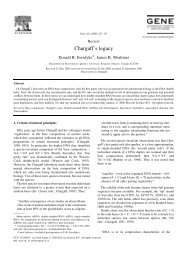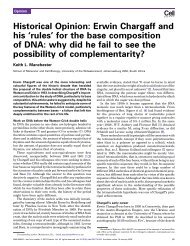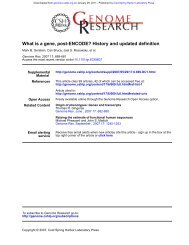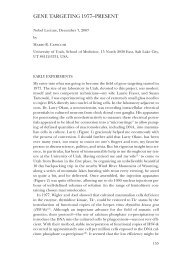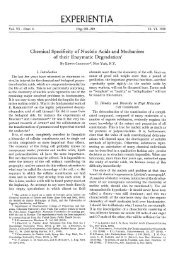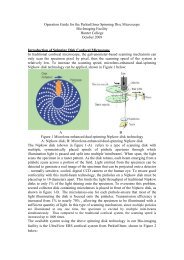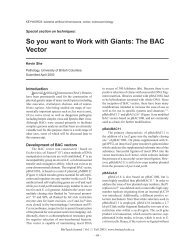Cold Spring Harb Symp Quant Biol-1953-Watson-SQB ... - Biology
Cold Spring Harb Symp Quant Biol-1953-Watson-SQB ... - Biology
Cold Spring Harb Symp Quant Biol-1953-Watson-SQB ... - Biology
You also want an ePaper? Increase the reach of your titles
YUMPU automatically turns print PDFs into web optimized ePapers that Google loves.
Downloaded from symposium.cshlp.org on March 26, 2009 - Published by <strong>Cold</strong> <strong>Spring</strong> <strong>Harb</strong>or Laboratory Press<br />
THE STRUCTURE OF DNA<br />
J. D. WATSON i AND F. H. C. CRICK<br />
Cavendish Laboratory, Cambridge, England<br />
(Contribution to the Discussion of Provirus.)<br />
It would be superfluous at a <strong>Symp</strong>osium on Viruses<br />
to introduce a paper on the structure of DNA<br />
with a discussion on its importance to the problem<br />
of virus reproduction. Instead we shall not only<br />
assume that DNA is important, but in addition that<br />
it is the carrier of the genetic specificity of the<br />
virus (for argument, see Hershey, this volume) and<br />
thus must possess in some sense the capacity for<br />
exact self-duplication. In this paper we shall describe<br />
a structure for DNA which suggests a mechanism<br />
for its self-duplication and allows us to propose,<br />
for the first time, a detailed hypothesis on<br />
the atomic level for the self-reproduction of genetic<br />
material.<br />
We first discuss the chemical and physical-chemical<br />
data which show that DNA is a long fibrous<br />
molecule. Next we explain why crystallographic<br />
evidence suggests that the structural unit of DNA<br />
consists not of one but of two polynucleotide chains.<br />
We then discuss a stereochemical model which we<br />
believe satisfactorily accounts for both the chemical<br />
and crystallographic data. In conclusion we suggest<br />
some obvious genetical implications of the<br />
proposed structure. A preliminary account of some<br />
of these data has already appeared in Nature (<strong>Watson</strong><br />
and Crick, <strong>1953</strong>a, <strong>1953</strong>b).<br />
I. EVIDENCE FOR THE FIBROUS NATURE OF DNA<br />
The basic chemical formula of DNA is now well<br />
established. As shown in Figure 1 it consists of a<br />
very long chain, the backbone of which is made up<br />
of alternate sugar and phosphate groups, joined together<br />
in regular 3' 5' phosphate di-ester linkages.<br />
To each sugar is attached a nitrogenous base, only<br />
four different kinds of which are commonly found<br />
in DNA. Two of these---adenine and guanine---<br />
are purines, and the other two thymine and cytosine-are<br />
pyrimidines. A fifth base, 5-methyl<br />
cytosine, occurs in smaller amounts in certain organisms,<br />
and a sixth, 5-hydroxy-methyl-cytosine, is<br />
found instead of cytosine in the T even phages<br />
(Wyatt and Cohen, 1952).<br />
It should be noted that the chain is unbranched,<br />
a consequence of the regular internucleotide ]inkage.<br />
On the other hand the sequence of the different<br />
nucleotides is, as far as can he ascertained,<br />
completely irregular. Thus, DNA has some features<br />
which are regular, and some which are irregular.<br />
A similar conception of the DNA molecule as a<br />
1 Aided by a Fellowship from the National Foundation<br />
for Infantile Paralysis.<br />
[123]<br />
long thin fiber is obtained from physico-chemieal<br />
analysis involving sedimentation, diffusion, light<br />
scattering, and viscosity measurements. These techniques<br />
indicate that DNA is a very asymmetrical<br />
structure approximately 20 A wide and many thousands<br />
of angstroms long. Estimates of its molecular<br />
weight currently center between 5 X 10 ~ and<br />
107 (approximately 3 )< 104 nucleotides). Surprisingly<br />
each of these measurements tend to suggest<br />
that the DNA is relatively rigid, a puzzling<br />
finding in view of the large number of single bonds<br />
(5 per nucleotide) in the phosphate-sugar back-<br />
BASE<br />
D.N.A.<br />
SUGAR<br />
\<br />
/<br />
BASE-- SUGAR<br />
BASE<br />
BASE<br />
BASE<br />
SUGAR<br />
\<br />
/<br />
\<br />
/<br />
- SUGAR<br />
\<br />
/<br />
\<br />
SUGAR<br />
PHOSPHATE<br />
PHOSPHATE<br />
PHOSPHATE<br />
PHOSPHATE<br />
PHOSPHATE<br />
Fmurm 1. Chemical formula (diagrammatic) of a single<br />
chain of desoxyribonucleic acid.



